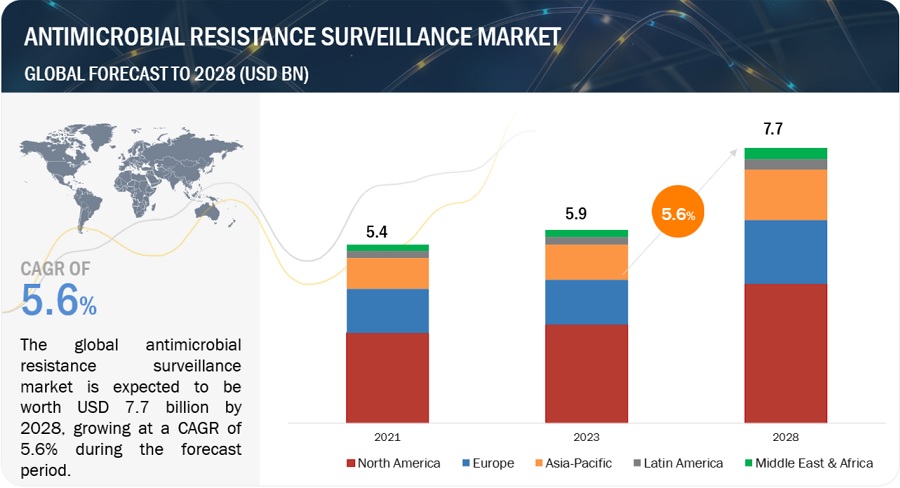The global antimicrobial resistance surveillance market is projected to grow from $5.9 billion in 2023 to $7.7 billion by 2028, with a CAGR of 5.6% over this period. This growth is driven by the rising prevalence of infections caused by drug-resistant pathogens, advancements in diagnostic technologies, and increased government initiatives to combat antimicrobial resistance.

Key Trends and Drivers
Rising Drug-Resistant Infections
Infections caused by drug-resistant pathogens like MRSA, VRE, MDR-TB, and CRE are increasing. For instance, the incidence of VRE infections in India has risen significantly, with bloodstream infections increasing from 6.12% in 2018 to 19.2% in 2020. This surge in infections is driving the demand for advanced antimicrobial resistance surveillance solutions.
Innovations in Diagnostics
The demand for rapid and accurate diagnostics for antimicrobial resistance is growing, with diagnostic kits expected to account for the largest market share in 2023. These kits detect antimicrobial-resistant bacteria in clinical samples, which is crucial for effective treatment.
Government Initiatives
Government programs aimed at combating antimicrobial resistance are bolstering market growth. For example, a Russian Federation-funded FAO initiative provided significant support to several countries to address antibiotic-resistant microbes in agriculture and food systems.
Challenges and Opportunities
The high cost of antimicrobial resistance diagnostic systems poses a barrier to widespread adoption, particularly in academic research labs with limited budgets. However, emerging economies like India, China, and Brazil present significant growth opportunities due to their increasing antibiotic usage and the advent of new illnesses.
Regulatory Hurdles
The antimicrobial resistance surveillance market faces challenges due to complex regulatory frameworks. The time lag in establishing clinical breakpoints and approving new antimicrobial agents complicates the market dynamics.
Market Segmentation
By Solution
- Diagnostic Kits: Expected to lead the market in 2023 due to their critical role in detecting antimicrobial resistance.
- Diagnostic Systems
- Surveillance Software
- Services
By Application
- Clinical Diagnostics: Anticipated to hold the largest market share in 2023, driven by the need for improved patient outcomes and accurate antimicrobial susceptibility testing.
- Public Health Surveillance
- Other Applications
By End User
- Hospitals & Clinics: Predicted to dominate the market as they are primary settings for antimicrobial-resistant infections.
- Research & Academic Institutes
- Others
By Region
- North America: Expected to account for the largest market share in 2023 due to the presence of leading market players and a strong regulatory environment.
- Europe
- Asia Pacific
- Latin America
- Middle East & Africa
Leading Companies
Prominent players in the antimicrobial resistance surveillance market include Luminex Corporation, Thermo Fisher Scientific, BioSpace, Cepheid, Accelerate Diagnostics, Liofilchem S.r.l., Becton, Dickinson and Company, Biomerieux, Bruker, Danaher, Merck KgaA, Bio-Rad, Qiagen, Abbott Laboratories, Roche Diagnostics, OpGen, Inc., Wolters Kluwer N.V., Lumed, Alifax S.r.l., and Bioanalyse.
Conclusion
The antimicrobial resistance surveillance market is set for significant growth, driven by the increasing prevalence of drug-resistant infections and innovations in diagnostic technologies. While high costs and regulatory complexities pose challenges, emerging economies offer substantial growth opportunities. The market is segmented into diagnostic kits, systems, software, services, clinical diagnostics, public health surveillance, hospitals, clinics, and various regions, with North America leading the charge.
